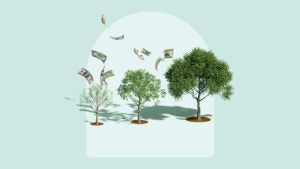Savings account checklist: Documents you need to open an account

Key takeaways
- You need proper identification to open a savings account, including your driver’s license or passport and your Social Security Number or Taxpayer Identification Number.
- You’ll also need to provide some personal information, including your date of birth, proof of address and contact information.
- Most banking institutions allow you to open a savings account online, which typically takes 15 minutes or less when you’re prepared with proper documentation and a method for making your initial deposit if required.
Opening a savings account is a quick and easy process. In most cases, you can do it from your home. To make the process even easier, make sure you have all the documents and information needed to open a savings account.
Checklist: What you need to open a savings account
Before you compare accounts at different banks and credit unions, here’s what you’ll need for your application:
- Government-issued ID: A driver’s license or passport.
- Social Security Number: Some banks will accept an Individual Taxpayer Identification Number (ITIN) if you don’t have a Social Security number.
- Date of birth: You usually have to be 18 years or older to open a bank account on your own, but you can open a joint account with a parent as a minor.
- Proof of address: This can be a utility bill, credit card statement or other verified document with your name and address on it.
- Contact information: This typically includes your name, address, phone number and email.
- Bank account information: Many banks will require an initial deposit, so have your account and routing number from your checking account. If you’re opening the account online, you may be able to fund it using a peer-to-peer payment service, such as Zelle or PayPal.
Things to consider when opening your savings account
Consider a few key factors to find a savings account that will fit your needs and help you grow your money.
Deposit insurance
Look for financial institutions that offer deposit insurance. Banks should be insured through the Federal Deposit Insurance Corp. (FDIC), while credit unions are insured through the National Credit Union Administration (NCUA).
Most institutions insure up to $250,000 in an individual savings account in the unlikely event that the institution fails.
Interest rate
When you save, you pay yourself. Depending on where you open a high-yield savings account, the bank or credit union will also pay you, too, with interest.
While most big banks are offering savings rates under 0.1 percent APY, many other high-yielding banks — often online banks — currently have savings accounts with rates over 4 percent APY and charge little to no fees.
You may also find that some savings accounts have tier-based interest rates, meaning you can qualify for higher rates with a greater account balance.
Features
You will likely have a range of saving needs. With that in mind, compare the functionality of different savings accounts.
For example, some banks offer the convenience of creating sub-savings accounts that can make a big difference with your mental accounting. One sub-account might be named “vacation fund” while another is “tuition fund.” This can help you distinguish between saving for different purposes.
Expert advice: How to maximize your savings account
Developing strong financial habits is key to getting the most out of your savings account. Here are some strategies to help you get started on your savings journey:
- Make saving a routine: Automate the process to stay consistent. Ask your employer to directly deposit a portion of your paycheck into your savings account, or set up monthly transfers from your checking account. This “set-it-and-forget-it” approach ensures you will continue to save — without having to think about it again.
- Save more early on: If you’re just starting out, saving at least 10 to 15 percent of your income — or more if your budget allows — can lay the groundwork for long-term financial success. As your earnings grow over your career, larger contributions and the power of compound interest will help your savings grow significantly.
- Leverage unexpected savings opportunities: Look for ways to boost your savings when surprise cash comes your way, such as tax refunds, gifts or even small amounts saved from using coupons. Resisting the urge to spend unexpected money right away can play a key part in growing your savings account over time.
- Reassess your savings goals regularly: Your savings needs change as you progress through life. For example, your emergency fund that covers six months of expenses will likely be much lower when you’re a single 20-something compared to when you’re 55 with kids in college. The target for your savings will always be moving. Make sure you’re adjusting your strategy to maintain the cushion you need to cover any unplanned costs.
Frequently asked questions (FAQs)
Can I open just a savings account?
Yes, you can generally open a savings account without any additional bank accounts. However, having additional bank accounts, such as a checking account (even if it’s at a different bank), will make funding your savings account easier.
What types of savings accounts are available?
The two most common types of savings accounts available are traditional savings accounts and high-yield savings accounts. Traditional savings accounts, typically offered by big-name brick-and-mortar banks, often pay you a fraction of a percent in interest on your money. High-yield savings accounts, on the other hand, are usually offered by online banks and financial institutions, which can offer you higher interest rates.
Is there a minimum deposit required to open a savings account?
The typical minimum deposit required to open a savings account is between $25 and $100, but a lot of banks and financial institutions don’t have this requirement at all. However, it’s worth noting that you may have to maintain certain balance requirements on your savings account to avoid fees and earn the best interest rates.
Will opening a savings account affect my credit score?
Opening a savings account should not affect your credit score. Since you are not borrowing money, the bank does not need to pull your credit report.
Bottom line
Opening a savings account doesn’t require much work whether it’s an online or traditional bank account, as long as you come to your local branch with documents prepared or have them ready to upload or enter if applying online. What typically requires more work is the research you put into finding the right account. But it pays to find the best savings account to suit your needs and earn an attractive rate.







